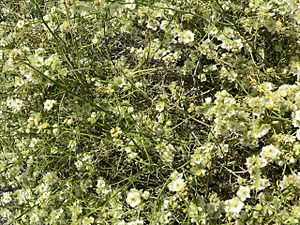Cheesebush facts for kids
Quick facts for kids Cheesebush |
|
|---|---|
 |
|
| Scientific classification | |
| Genus: |
Ambrosia
|
| Species: |
salsola
|
| Synonyms | |
|
|
Ambrosia salsola, often called cheesebush, winged ragweed, or burrobush, is a cool plant found in the deserts of the southwestern United States and northwestern Mexico. It's a type of perennial shrub, which means it lives for more than two years. This plant is part of the sunflower family. It's famous for its strong, unique smell, which some people think smells like cheese! This plant can also mix its genes with a similar plant called white bur-sage (Ambrosia dumosa).
Contents
Where Cheesebush Grows
Cheesebush is very common in sandy desert areas. You can often spot it in dry riverbeds, called desert dry washes. It also grows easily in places where the ground has been disturbed. This includes areas like creosote bush scrub and Joshua tree woodland.
Native Homes
This plant is native to several states in the southwestern United States. These include Arizona, California, Nevada, and Utah. It also grows naturally in northwestern Mexico, in places like Sonora, Baja California, and Baja California Sur.
Preferred Environments
Cheesebush loves sandy and gravelly soil. Sometimes, it even grows on lava formations! You can find it at different heights, from about 650 feet (200 meters) to nearly 6,000 feet (1,800 meters) above sea level. It does well in alkaline environments, which means the soil has a higher pH.
How Cheesebush Grows
Cheesebush usually grows to be about 2 to 3 feet tall. It's a shrub that can sometimes reach up to 5 feet (150 cm) high. Some types can even spread out to be 8 feet wide!
Dealing with Heat
When it gets super hot and dry in the summer, cheesebush is smart. It drops about half of its leaves and some small branches. This helps it save water during dry conditions. This ability is called being "drought deciduous."
Leaves and Stems
The stems of the cheesebush are thin. Its leaves are narrow and look like needles. They can be up to 2.5 inches (65 mm) long but are only about 0.06 inches (1.5 mm) wide.
Why "Cheesebush"?
If you crush the leaves or the tips of the stems, you'll notice a strong, pungent smell. Many people describe this scent as being like cheese. That's how the plant got its common name, "cheesebush"!
Flowers and Fruits
Cheesebush plants bloom with many small flowers from March to June. These flowers can be white or yellow.
Flower Types
The plant has two kinds of flowers: male and female.
- Male flowers are small and cup-shaped. They grow in clusters that look like spikes.
- Female flowers are found lower down, near where the leaves meet the stem. Each female flower head has only one flower.
- Male flower heads can have 5 to 15 flowers in them.
Pearly Fruits
After the flowers, the plant produces many pearly, winged fruits. These fruits can be white, yellow, or even pink. They look quite pretty!

